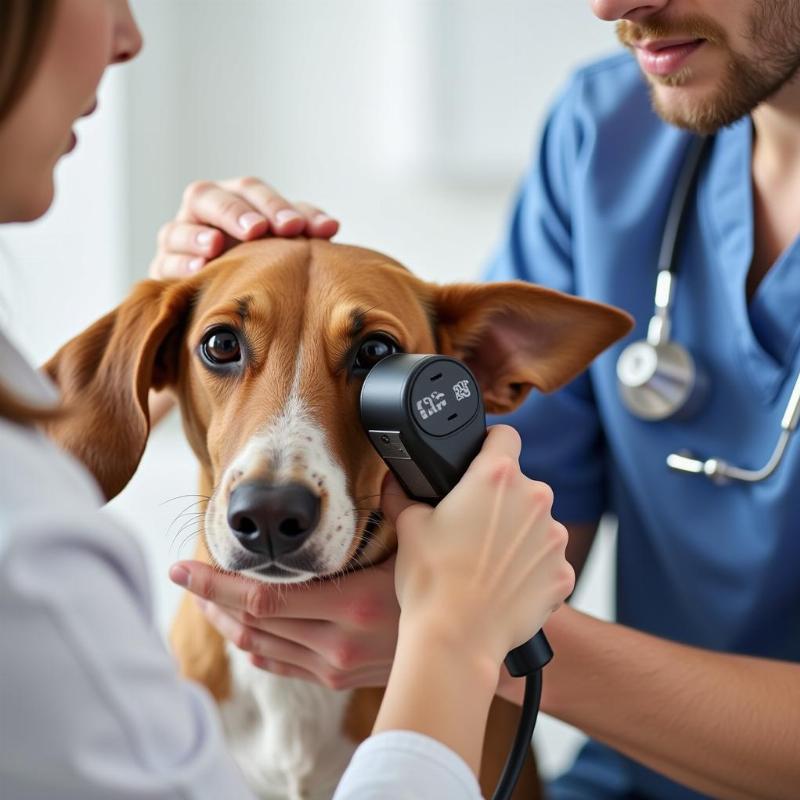Ketoconazole ear flush is a common treatment for dog ear infections, particularly those caused by yeast or fungi. Understanding when and how to use a ketoconazole ear flush is essential for effectively managing your dog’s ear health and preventing recurring infections. This guide will provide pet owners with valuable insights into ketoconazole ear flushes, including their benefits, potential side effects, and proper administration techniques.
Understanding Ketoconazole Ear Flush for Dogs
Ketoconazole is an antifungal medication that works by disrupting the growth of yeast and fungi. It’s often prescribed by veterinarians for various fungal infections, including those affecting a dog’s ears. A ketoconazole ear flush is a liquid solution specifically formulated for cleaning and treating infected ears. While effective, it’s crucial to remember that a ketoconazole ear flush should only be used under the guidance of a veterinarian. They can diagnose the underlying cause of the infection and ensure that ketoconazole is the appropriate treatment.
Why Would a Vet Prescribe a Ketoconazole Ear Flush?
Your veterinarian might prescribe a ketoconazole ear flush if your dog exhibits symptoms of a yeast or fungal ear infection, such as excessive scratching, head shaking, redness, swelling, discharge, and an unpleasant odor. These infections can be caused by various factors, including allergies, moisture buildup, and underlying health conditions.
What are the Signs of a Dog Ear Infection?
Recognizing the signs of a dog ear infection is crucial for early intervention. Some common indicators include:
- Frequent scratching at the ears
- Head shaking or tilting
- Redness and swelling in the ear canal
- Yellowish or brownish discharge
- Foul odor emanating from the ears
- Pain or sensitivity when the ears are touched
How to Administer Ketoconazole Ear Flush
Administering a ketoconazole ear flush correctly is crucial for effective treatment. Follow these steps:
- Clean the outer ear with a veterinarian-approved ear cleaner.
- Gently lift the ear flap and fill the ear canal with the prescribed amount of ketoconazole ear flush.
- Massage the base of the ear for 30-60 seconds to distribute the solution.
- Allow your dog to shake its head to remove excess solution and debris.
- Wipe the outer ear clean with a cotton ball.
Can I use a ketoconazole ear flush without a vet’s prescription?
No, you should never use a ketoconazole ear flush without a veterinarian’s prescription. Using the wrong medication or dosage can worsen the infection or cause other health problems.
 Veterinarian Examining a Dog's Ear
Veterinarian Examining a Dog's Ear
Potential Side Effects of Ketoconazole Ear Flush
While generally safe, ketoconazole ear flush can occasionally cause side effects, such as temporary hearing loss, redness, or itching. If you notice any adverse reactions, contact your veterinarian immediately.
Preventing Recurring Ear Infections in Dogs
Preventing recurring ear infections involves regular ear cleaning, managing allergies, and addressing underlying health conditions. Your veterinarian can recommend preventative measures tailored to your dog’s specific needs.
Conclusion
Ketoconazole ear flush can be a highly effective treatment for fungal ear infections in dogs. However, it’s essential to use it under veterinary supervision and follow the prescribed instructions carefully. By understanding the proper usage and potential side effects, you can help your furry friend maintain healthy ears and a happy, comfortable life.
FAQ
- How often should I apply ketoconazole ear flush to my dog? Follow your veterinarian’s instructions regarding the frequency and duration of treatment.
- Can I use human ketoconazole cream on my dog’s ears? No, never use human medications on your dog without consulting a veterinarian.
- What should I do if my dog’s ear infection doesn’t improve with ketoconazole? Contact your veterinarian, as a different medication or treatment approach may be necessary.
- Are there any home remedies for dog ear infections? While some home remedies may provide temporary relief, it’s crucial to consult a veterinarian for proper diagnosis and treatment.
- How can I prevent my dog from developing ear infections? Regular ear cleaning, allergy management, and addressing underlying health conditions can help prevent ear infections.
- Can swimming contribute to ear infections in dogs? Yes, excess moisture in the ears can create a breeding ground for bacteria and yeast, increasing the risk of infection.
- What are the long-term consequences of untreated ear infections in dogs? Untreated ear infections can lead to chronic pain, hearing loss, and other serious complications.
Beautdogs.us is your premier source for comprehensive dog care information, breed-specific guidance, and product recommendations. We are committed to providing dog owners with reliable and engaging content to enhance the well-being of their furry companions. Whether you’re a new dog owner or a seasoned expert, Beautdogs.us is your trusted resource for all things canine. Contact us today! Email: [email protected], Phone: +1 501-555-7529.